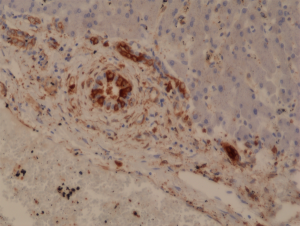
Immunohistochemical staining of formalin fixed and paraffin embedded human Liver tissue section using anti-GSTP1 rabbit monoclonal antibody (Clone RM347) at a 1:20000 dilution.
anti-GST3/GST pi (human), Rabbit Monoclonal (RM347)

REV-31-1233-00
ApplicationsWestern Blot, ImmunoHistoChemistry
Product group Antibodies
ReactivityHuman
TargetGSTP1
Overview
- SupplierRevMAb Biosciences
- Product Nameanti-GST3/GST pi (human), Rabbit Monoclonal (RM347)
- Delivery Days Customer5
- ApplicationsWestern Blot, ImmunoHistoChemistry
- CertificationResearch Use Only
- ClonalityMonoclonal
- Clone IDRM347
- Gene ID2950
- Target nameGSTP1
- Target descriptionglutathione S-transferase pi 1
- Target synonymsdeafness, X-linked 7; DFN7; epididymis secretory protein Li 22; FAEES3; fatty acid ethyl ester synthase III; glutathione S-transferase P; GST class-pi; GST3; GSTP; GSTP1-1; HEL-S-22; PI
- HostRabbit
- IsotypeIgG
- Scientific DescriptionInhibition of free radicals and the damage they produce is critical for cell survival, particularly in neurons. Glutathione S-transferases (GSTs) are a class of inducible, multifunctional, detoxifying enzymes that catalyze the reduction of hydrophobic electrophiles, like those generated by pesticides and chemotherapeutic compounds. In mammals, six different isoforms alpha, mu, pi, theta, omega, and zeta have been identified. GST-Pi is expressed in many human tissues, particularly in the biliary tree, renal distal convoluted tubules and lungs. GST-Pi overexpression has been observed in many tumors compared with the surrounding normal tissues and in various cancer cell lines resistant to anticancer agents. It has been shown that GST-Pi acts as a regulator of mitogen-activated protein (MAP) kinases. GST-Pi is an endogenous inhibitor of c-Jun NH2-terminal kinase (JNK), mediated by interactions with the NH2-terminal region of the kinase. After oxidative stress, GST-Pi oligomerizes and disassociates from JNK, which then becomes phosphorylated. GST-Pi can also modulate the activation of p38 and extracellular signal-regulated kinase (ERK). - Recombinant Antibody. This antibody reacts to human GST3/GST-pi (Glutathione S-transferase P). Applications: WB, IHC. Source: Rabbit. Liquid. 50% Glycerol/PBS with 1% BSA and 0.09% sodium azide. Inhibition of free radicals and the damage they produce is critical for cell survival, particularly in neurons. Glutathione S-transferases (GSTs) are a class of inducible, multifunctional, detoxifying enzymes that catalyze the reduction of hydrophobic electrophiles, like those generated by pesticides and chemotherapeutic compounds. In mammals, six different isoforms alpha, mu, pi, theta, omega, and zeta have been identified. GST-Pi is expressed in many human tissues, particularly in the biliary tree, renal distal convoluted tubules and lungs. GST-Pi overexpression has been observed in many tumors compared with the surrounding normal tissues and in various cancer cell lines resistant to anticancer agents. It has been shown that GST-Pi acts as a regulator of mitogen-activated protein (MAP) kinases. GST-Pi is an endogenous inhibitor of c-Jun NH2-terminal kinase (JNK), mediated by interactions with the NH2-terminal region of the kinase. After oxidative stress, GST-Pi oligomerizes and disassociates from JNK, which then becomes phosphorylated. GST-Pi can also modulate the activation of p38 and extracellular signal-regulated kinase (ERK).
- ReactivityHuman
- Storage Instruction-20°C
- UNSPSC12352203
